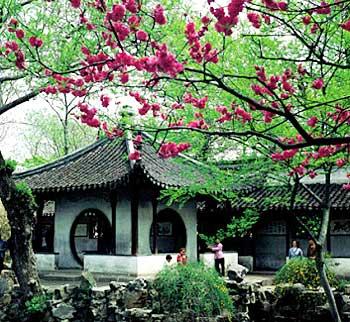
 |
| The Tianquan Pavilion in the Humble Administrator's Garden (CNTV) |
Suzhou, located in Jiangsu Province in eastern China, is a renowned Chinese historical and cultural city and is well-known worldwide for its beautiful scenery and classical gardens. An old saying goes, "the gardens south of the Yangtze River are the best under Heaven, and among them, the gardens of Suzhou top them all." The history of Suzhou gardens can be traced back to the Spring and Autumn Period in the 6th century B.C., when the emperor of the Wu state built his garden in Suzhou. The Pijiang Garden was recorded as the earliest private garden dating from the 4th century during the Eastern Jin Dynasty. Private gardens then became a popular trend and many renowned gardens were built afterwards. During the Ming and Qing dynasties, Suzhou became one of the most flourishing areas in China and private gardens were built in and outside the city. The Suzhou gardens entered their prime between the 16th century and the 18th century. Now in Suzhou, there are more than 200 gardens, dozens of which have been well preserved. Therefore, Suzhou enjoys the fame of "Heaven on Earth."
The Surging Waves Pavilion, the Lion Grove Garden, the Humble Administrator's Garden and the Lingering Garden represent the artistic styles of the Song Dynasty (between 960 A.D. and 1278 A.D.), Yuan Dynasty (between 1271 A.D. and 1368 A.D.), Ming Dynasty (between 1368 A.D. and 1644 A.D.) and Qing Dynasty (between 1644 A.D. and 1911 A.D.) respectively. They are called Suzhou's four most famous gardens. The Master of the Nets Garden also enjoys great fame.


















 Wild Siberian tiger kills cattle in NE China
Wild Siberian tiger kills cattle in NE China


![]()
